A survey of the stellar nursery in the Orion Nebula Cluster provides evidence that stars compete for material and their size depends on what they gather rather than their initial core size. Plus, NASA mission updates, fast radio bursts, neutron stars, visible novae, and mountain building in the Andes.
Media
Transcript
Hello and welcome to the Daily Space. I am your host Dr. Pamela Gay.
And I am your host Beth Johnson.
And we are here to put science in your brain.
On April 19 at 0734 UTC, NASA’s Mars Helicopter Ingenuity successfully performed the first powered flight from the surface of another planet. It was relatively short, only to a three-meter altitude and with a flight time of just over 39 seconds, but it made history. This was the first time something flew in the atmosphere of another planet!
Overcompensating on the interesting side of things, on one of our days off, NASA released images of the site on the asteroid Bennu where the OSIRIS-REx mission punched an asteroid. I have to say, every time I read or hear about what happened, new details make the story even more interesting.
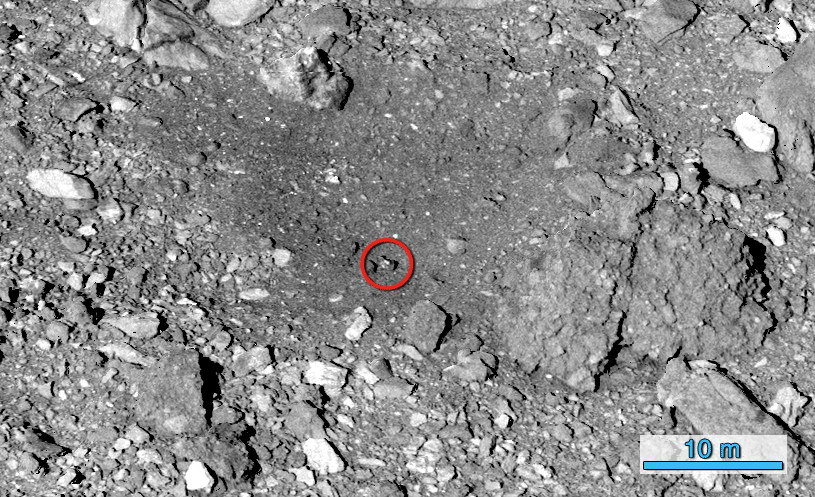
The intention was to boop the asteroid with the mission’s sample arm, blast it with an air canister to launch some material into the sample container, and then fly away after just a couple of seconds. This is still what is shown in released animations. What actually happened caused a massive stirring up of material in the crater. As we now know, the mission stabbed its arms into the surface, blasted the air canister while under the surface, and would have kept plunging into the asteroid if it hadn’t used reverse thrusters to escape after its arm was already 0.5 meters into the asteroid. To give you a sense of scale, this crater is roughly the size of a large parking spot, and the mission’s intended boop stirred up this entire region!
Spacecraft often make super surprising discoveries. We build them to accomplish one set of science objectives, and we give them what we hope is enough flexibility to handle any random discoveries that are made along the way. For one mission, the random discoveries started before the mission was even launched.
Lucy is an upcoming probe that will do flybys of Trojan asteroids – those chunks of rocks that share an orbit with Jupiter that are gravitationally clumped up ahead and behind the planet in its orbit around the Sun. This mission is being put on a very elliptical orbit that will allow it to visit first the leading Trojans, and then on its next orbit to visit the lagging Trojans. The orbit was specifically designed to allow the mission to do close flybys of seven known objects, and it’s expected newly discovered objects may be added over the course of the mission.
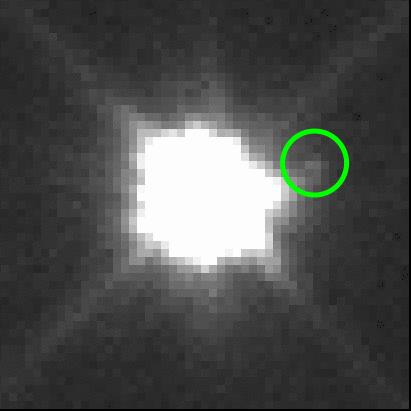
In January 2020, it was realized one object would actually be added beforehand: one of the seven Trojan asteroids was discovered to be a binary object. Continued observations using the ground-based Asteroid Terrestrial-impact Last Alert System (ATLAS) based in Hawaii have found that the leading and trailing clouds of asteroids have different average shapes, with the leading asteroids tending to be more elongated and smaller. According to research on ArXiv led by Andrew McNeill, the leading cloud also has more objects in it, and this combination of facts seems to indicate that with more objects to collide, more collisions have indeed taken place, each one reshaping the asteroids involved.
Launching in October of this year, Lucy is expected to reach this leading cloud in 2027 and then visit the trailing cloud in 2033. Expect more discoveries in the years before the encounters, as observers here work to make sure Lucy doesn’t encounter any surprises out there!
Not all of today’s news comes from within our solar system. One of our regular topics, fast radio bursts (FRBs), has a new advancement. First discovered in 2007, these are literally momentary flashes of energy that reach Earth in the radio portion of the electromagnetic spectrum. Often, there will be just a single flash from a place in the sky, and we can’t link to a single star or another object. Other times, we see recurring flashes.
To try and get a better sense of what might be happening, joint observations were made with the CHIME radio telescope in British Columbia and LOFAR in the northern Netherlands. CHIME operates at 500-800 Mhz, while LOFAR sees at longer wavelengths from 10 to 240 MHz, which extends to either side of the FM radio band. Working together, they observed recurring fast radio burst 20180916B. They discovered that the FRB emitted energy at the longer wavelengths, and these lower-energy photons arrived at LOFAR three days after the higher energy light was seen by CHIME.

According to study co-author Daniele Michilli: This systematic delay rules out explanations for the periodic activity that do not allow for the frequency dependence and thus brings us a few steps closer to understanding the origin of these mysterious bursts.
This work appears in The Astrophysical Journal Letters and was led by Ziggy Pleunis.
While we don’t know what fast radio bursts are, there are hints they are some kind of neutron star that has a massive magnetic field that periodically rearranges itself and lets off a massive burst of energy. We see other objects, including our own Sun with its solar flares, exhibiting this kind of energetic, magnetic field-related behavior. If fast radio bursts do come from neutron stars, this means that some of the smallest glowing objects in the sky are also responsible for some of the most energetic crackles we detect.
Neutron stars are the dead remnants of massive stars that aren’t massive enough to explode as supernovae but are massive enough that when they are no longer able to produce energy through fusion, will collapse down and crush their atoms into exotic forms of matter.
Neutron stars are roughly the size of Manhatten Island and can contain a bit more than two times the Sun’s mass in stuff. Theories suggest that the outer skin can be fairly normal matter, but inside the dead star, pressure forces protons and electrons to combine into a dense degenerate gas of neutrons. What we didn’t know was if the super-dense core was just neutrons or some more compact form of matter, like a quark soup.
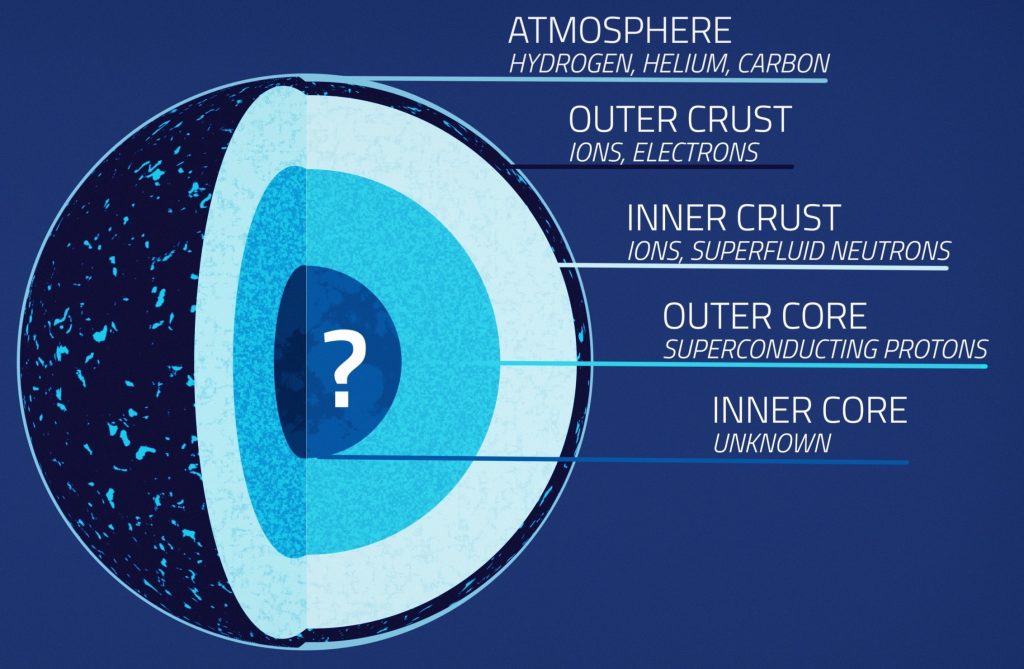
New research from the ISS’s NICER X-ray Telescope looks at one of the largest mass neutron stars out there, pulsar J0740+6620, to see if its size can reveal its inner nature. They also looked at the average-massed J0030+0451 for comparison. Early results indicate the higher mass pulsar is bigger than predicted by quark-soup-center theories and smaller than predicted by theories with just neutrons and protons. This was not expected and hints at new states of matter. According to the team lead, Cole Miller: NICER is not only rewriting the textbooks on neutron stars but also revolutionizing our confidence in our measurements of objects that are both very distant and very small.
According to study co-author Anna Watts: Our new measurements of J0740 show that even though it’s almost 50% more massive than J0030, it’s essentially the same size. That challenges some of the more squeezable models of neutron star cores, including versions where the interior is just a sea of quarks. J0740’s size and mass also pose problems for some less squeezable models containing only neutrons and protons.
Understanding what is inside neutron stars may help us understand black holes and allow us to get at new, fundamental physics that tells the story of the earliest moments of our universe.

Neutron stars and lower mass white dwarf stars are so dense that they can get closer to any potential companion stars they have than may be healthy for those companions. They literally will strip material off their companions in some cases, and that infalling material, when it gets dense enough, can explode in myriad different ways referred to as novae. Currently, three different novae are visible to small telescopes: V1710 Sco, V6595 Sgr, and V1405 Cas. All three systems appear to be classical novae: they are made up of a white dwarf star – an object about the size of the moon with the mass of the Sun – and a lower mass companion star that is being stripped of material. There is an excellent article on how to find these objects on the Sky & Telescope website, and we will link to that article on DailySpace.org.
One of the most stunning regions in the sky for amateur astronomers to observe is the Orion Star-Forming region. From the famous M42 nebula in the sword to the Horsehead nebula, to cloud after cloud of glowing nebulosity and knots of star formation, that region of the sky is a complex of star formation that allows researchers to see all the short-lived stages.
As we’ve said before and will say again, we don’t fully understand star and planet formation, but we understand the broadest brush strokes. At its initial stages, a giant molecular cloud will collapse and fragment into dense cores that will, over time, continue collapsing into a spinning disk with a protostar in its center. These systems can draw in more or less material, growing depending on what they can pull in. Over what time this occurs, well, that had been a bit of a mystery, and it was suspected that perhaps large stars were able to continue growing by drawing material from around them and possibly from neighbors forming around them!
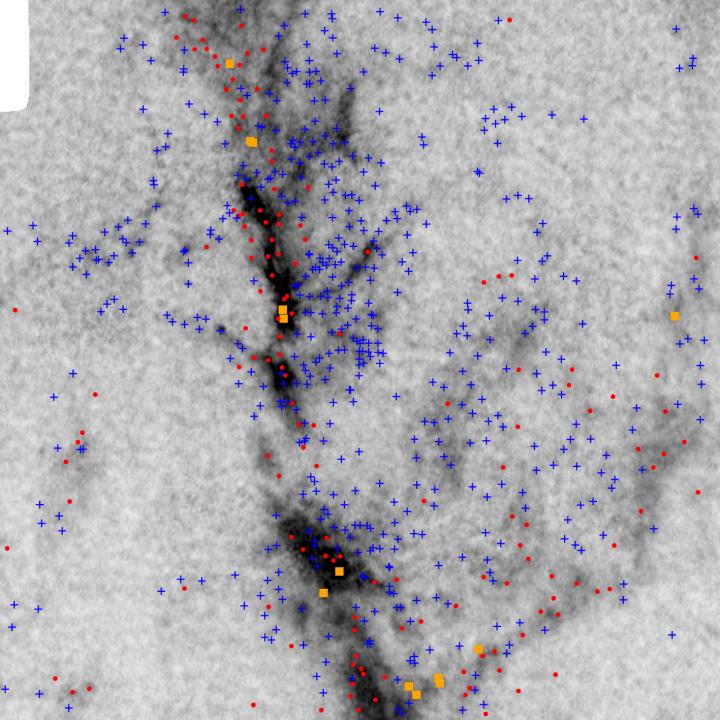
New observations taken with NAOJ’s Nobeyama 45-meter radio telescope find that the competition for resources occurs at the earliest stages of star formation, with dense cores already stealing materials to reach a size that reflects their final mass. The team looked at regions of star formation both at the earliest, dense cores of collapsing material stage and also at the newly formed stage of stars and found that the distribution of masses in these two kinds of systems are the same.
Prior to these results, it was thought that stars either formed through a competitive accretion model, where all stars start with roughly the same size dense core and over time grow more or less successfully; or that stars grow through a core-collapse model where different sized dense cores formed and led to different sized stars. These results indicate that, at least for the Orion Nebula, the core collapse model appears right. These observations are now being expanded to other star-forming regions to see if this is a universal result, or if, as so often happens, the universe is doing the same thing in multiple different ways.
What I love about this research is it is allowing us to really build a movie of star formation over time.
We talk a lot on the show about climate change, especially what we are undergoing now. The activities of humans have definitely had an impact on the current climate situation, but nature likes to have a hand in everything as well. And we’re still learning just how some of the larger processes, like mountain building, affected climate in the past and how they are being affected by climate change today.
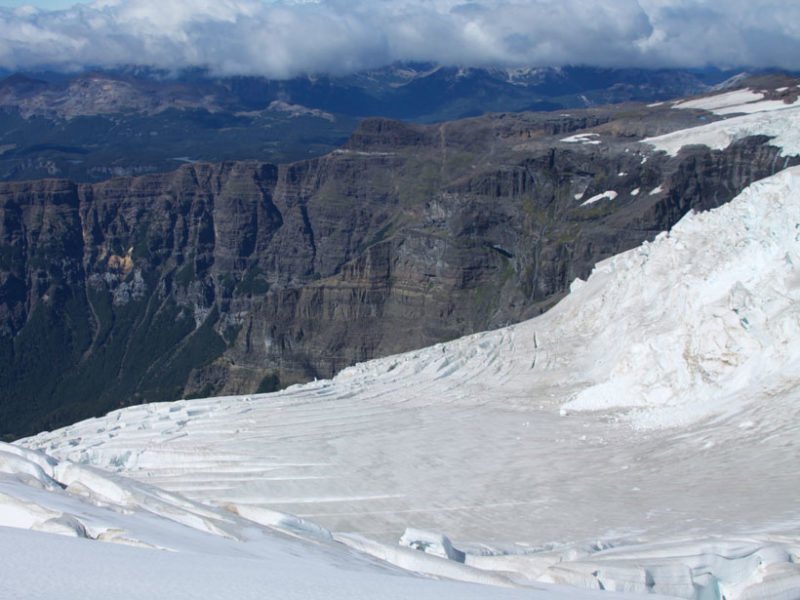
In a recent paper in the journal Tectonics, researchers theorized that a feedback loop existed between tectonic deformation and the climate about 13 to 7 million years ago in the North Patagonian Andes of South America. The team conducted field observations, focusing on an area called the “foreland basin”, which is to the east of the Andes and is basically the area behind the mountains that gets pushed back and folded up as the mountains rise.
The Andes began forming when the Nasca plate began to subduct under the South American plate. We talked a few episodes ago about how volcanic arcs form, and the Andes are essentially a volcanic arc formed on land instead of as islands. As these volcanoes grew, they deformed that foreland basin. The largest period of deformation occurred in that 13 to 7 million years ago window and then started to decrease. At that point, glaciation began in the mountains themselves.
Now, with the glaciers eroding away through warmer temps and increased rainfall, and not just due to the current climate change but extending back a couple of million years, the foreland basin deformation has stopped. And fault activity in the mountains has increased. Researchers now have the numbers to confidently say that climate change can actually affect mountain-building processes and not only the other way around.
Friendly reminder that the world is bigger than we sometimes realize and sometimes smaller, and it’s all tied together.
Speaking of the Andes, a recent paper published in the journal Latin American Antiquity examined how structures in the ancient city of Caral in Peru were oriented based on astronomy. The city itself, long since abandoned, dates back to around 3000 BCE, and the society that lived there was the Supe Culture, named for the river on which the city was built. And while much of that city is oriented parallel to the river, as one would expect from a predominantly agricultural society, several of the large and clearly important pyramidal buildings have an orientation that aligns with the full Moon and the June solstice.
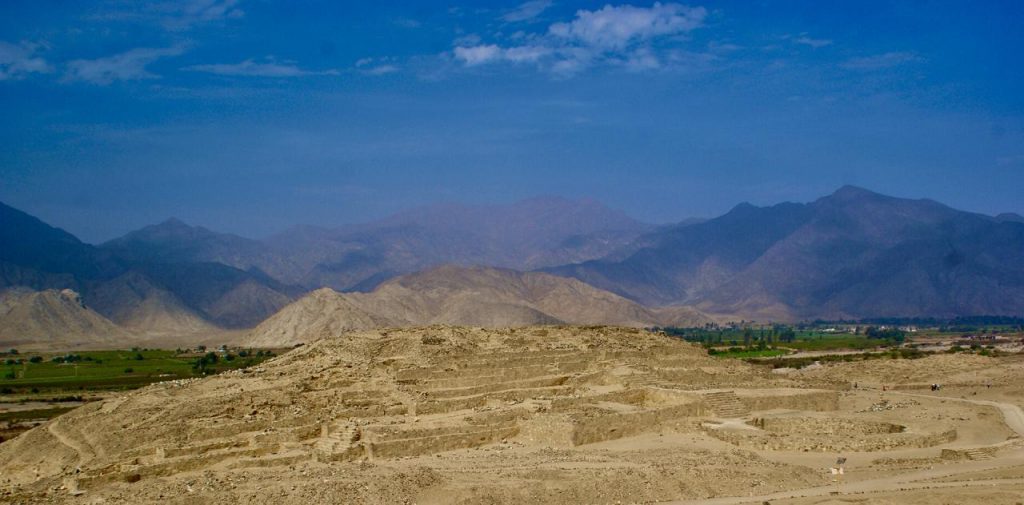
First author César González-García explains: It is noteworthy that these orientations can be related to the precipitation cycles on the Andean summits, with the consequent beneficial floodings of the river, and thus with the agricultural cycles. That time also coincided with the end of the fishing season, taking place over a wide area of the nearby coast.
Coauthor Juan Antonio Belmonte notes: The results of the research in the position and the orientation of the main buildings show that the presence of the River Supe is the main determining influence on the orientation of the buildings because although they are not sited directly at the river, they are systematically parallel to it in a curious phenomenon, convergent with what was occurring at the same time thousands of kilometers away in Valley of the Nile.
These monuments of the Supe valley culture from five thousand years ago are now the first, and therefore oldest, examples of pre-Colombian American interactions between the landscape and the sky. And that is your daily reminder to look up and observe how astronomy influences your life.
This has been the Daily Space.
Learn More
NASA’s Ingenuity Helicopter Has Successful First Flight
OSIRIS-REx Booped Bennu Harder Than Expected
- NASA press release
Upcoming Lucy Mission Team Discovers Target Asteroid is Binary
- SWRI press release
Fast Radio Bursts Include Lower Frequency Radio Waves, Too!
- McGill University press release
- “LOFAR Detection of 110–188 MHz Emission and Frequency-dependent Activity from FRB 20180916B,” Z. Pleunis et al., 2021 April 9, The Astrophysical Journal Letters
NASA’s NICER Probes the Squeezability of Neutron Stars
- NASA press release
- APS press release
- “Constraining the Neutron Star Mass–Radius Relation and Dense Matter Equation of State with NICER. III. Model Description and Verification of Parameter Estimation Codes,” Slavko Bogdanov et al., submitted to the Astrophysical Journal Letters (preprint on arxiv.org)
A Trio of Novae Visible in Night Sky
- Sky & Telescope article
Orion Nebula Observations Suggests Stars Grow Competitively
- NAOJ press release
- “The Core Mass Function in the Orion Nebula Cluster Region: What Determines the Final Stellar Masses?“, Hideaki Takemura et al., 2021 March 22, The Astrophysical Journal Letters
The Relationship Between Glaciation and Mountain Building in the Andes
- Eos article
- “The Influence of Climate on the Dynamics of Mountain Building Within the Northern Patagonian Andes,” Ezequiel García Morabito et al., 2020 December 25, Tectonics
Supe Culture Built City in Relation to Landscape and Astronomy
- IAC press release
- “The River and the Sky: Astronomy and Topography in Caral Society, America’s First Urban Centers,” A. César González-García et al., 2021 March 23, Latin American Antiquity
Credits
Written by Pamela Gay and Beth Johnson
Hosted by Pamela Gay
Audio and Video Editing by Ally Pelphrey
Content Editing by Beth Johnson
Intro and Outro music by Kevin MacLeod, https://incompetech.com/music/


 We record most shows live, on Twitch. Follow us today to get alerts when we go live.
We record most shows live, on Twitch. Follow us today to get alerts when we go live.